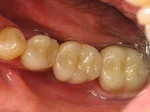This is a method of treating the inside of the tooth, also known as a root canal treatment. It is one of the most common dental procedures that can be performed to prevent tooth loss.
To help you understand endodontic treatment, we would like to familiarize you with the anatomy of your tooth. Inside your tooth, under the white tooth enamel and the hard layer of tooth, called dentin, is a soft tissue known as the pulp. The pulp consists of blood vessels, nerves and connective tissue which help to create the surrounding hard tissues of the tooth during development.
The pulp can be found in the center of the tooth and can extend all the way to the tip of the roots where it connects to the tissues surrounding the root. The pulp has a very important role during a tooth’s development. However, a tooth that has reached full maturity can survive without the pulp, because it continues to receive nourishment by the surrounding tissues.
Why do I need endodontic treatment?
If the soft tissue inside the root canal of a tooth becomes inflamed or infected, then a root canal treatment is necessary. There can be a variety of factors that cause the inflammation or infection such as: repeated dental procedures on the tooth, deep decay, crack s or chips in tooth.
What are the signs of needing endodontic
The endodontist removes the inflamed or infected pulp, carefully cleans and shapes the inside of the canal, a channel inside the root, then fills and seals the space. Afterwards, you will return to your dentist, who will place a crown or other restoration on the tooth to protect and restore it to full functions. After restoration, the tooth continues to function like any other tooth.
Many endodontic procedures are performed to relieve the pain of toothaches caused by pulp inflammation or infection. With modern techniques and anesthetics, most patients report that they are comfortable during the procedure. For the first few days after treatment, your tooth may feel sensitive, especially if there was pain or infection before the procedure. This discomfort can be relieved with over-the-counter or prescription medications. Follow your endodontic's instructions carefully. Your tooth may continue to feel slightly different from your teeth for some
Root Canal treatment Procedure
| |||||||||||||||





